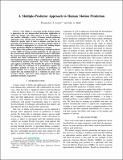| dc.contributor.author | Lasota, Przemyslaw Andrzej | |
| dc.contributor.author | Shah, Julie A | |
| dc.date.accessioned | 2018-06-04T14:57:09Z | |
| dc.date.available | 2018-06-04T14:57:09Z | |
| dc.date.issued | 2017-07 | |
| dc.identifier.isbn | 978-1-5090-4633-1 | |
| dc.identifier.uri | http://hdl.handle.net/1721.1/116050 | |
| dc.description.abstract | The ability to accurately predict human motion is imperative for any human-robot interaction application in which the human and robot interact in close proximity to one another. Although a variety of human motion prediction approaches have already been developed, they are often designed for specific types of tasks or motions, and thus do not generalize well. Furthermore, it is not always obvious which of these methods is appropriate for a given task, making human motion prediction difficult to implement in practice. We address this problem by introducing a multiple-predictor system (MPS) for human motion prediction. In our approach, the system learns directly from task data in order to determine the most favorable parameters for each implemented prediction method and which combination of these predictors to use. Our implementation consists of three complementary methods: velocity-based position projection, time series classification, and sequence prediction. We describe the process of forming the MPS and our evaluation of its performance against the individual methods in terms of accuracy of predictions of human position over a range of look-ahead time values. We report that our method leads to a reduction in mean error of 18.5%, 28.9%, and 37.3% when compared with the three individual methods, respectively. | en_US |
| dc.description.sponsorship | United States. National Aeronautics and Space Administration. Space Technology Research Fellowship | en_US |
| dc.publisher | Institute of Electrical and Electronics Engineers (IEEE) | en_US |
| dc.relation.isversionof | http://dx.doi.org/10.1109/ICRA.2017.7989265 | en_US |
| dc.rights | Creative Commons Attribution-Noncommercial-Share Alike | en_US |
| dc.rights.uri | http://creativecommons.org/licenses/by-nc-sa/4.0/ | en_US |
| dc.source | MIT Web Domain | en_US |
| dc.title | A multiple-predictor approach to human motion prediction | en_US |
| dc.type | Article | en_US |
| dc.identifier.citation | Lasota, Przemyslaw A., and Julie A. Shah. “A Multiple-Predictor Approach to Human Motion Prediction.” 2017 IEEE International Conference on Robotics and Automation (ICRA) (May 2017). | en_US |
| dc.contributor.department | Massachusetts Institute of Technology. Department of Aeronautics and Astronautics | en_US |
| dc.contributor.mitauthor | Lasota, Przemyslaw Andrzej | |
| dc.contributor.mitauthor | Shah, Julie A | |
| dc.relation.journal | 2017 IEEE International Conference on Robotics and Automation (ICRA) | en_US |
| dc.eprint.version | Author's final manuscript | en_US |
| dc.type.uri | http://purl.org/eprint/type/ConferencePaper | en_US |
| eprint.status | http://purl.org/eprint/status/NonPeerReviewed | en_US |
| dc.date.updated | 2018-04-10T17:16:01Z | |
| dspace.orderedauthors | Lasota, Przemyslaw A.; Shah, Julie A. | en_US |
| dspace.embargo.terms | N | en_US |
| dc.identifier.orcid | https://orcid.org/0000-0002-1761-221X | |
| dc.identifier.orcid | https://orcid.org/0000-0003-1338-8107 | |
| mit.license | OPEN_ACCESS_POLICY | en_US |
